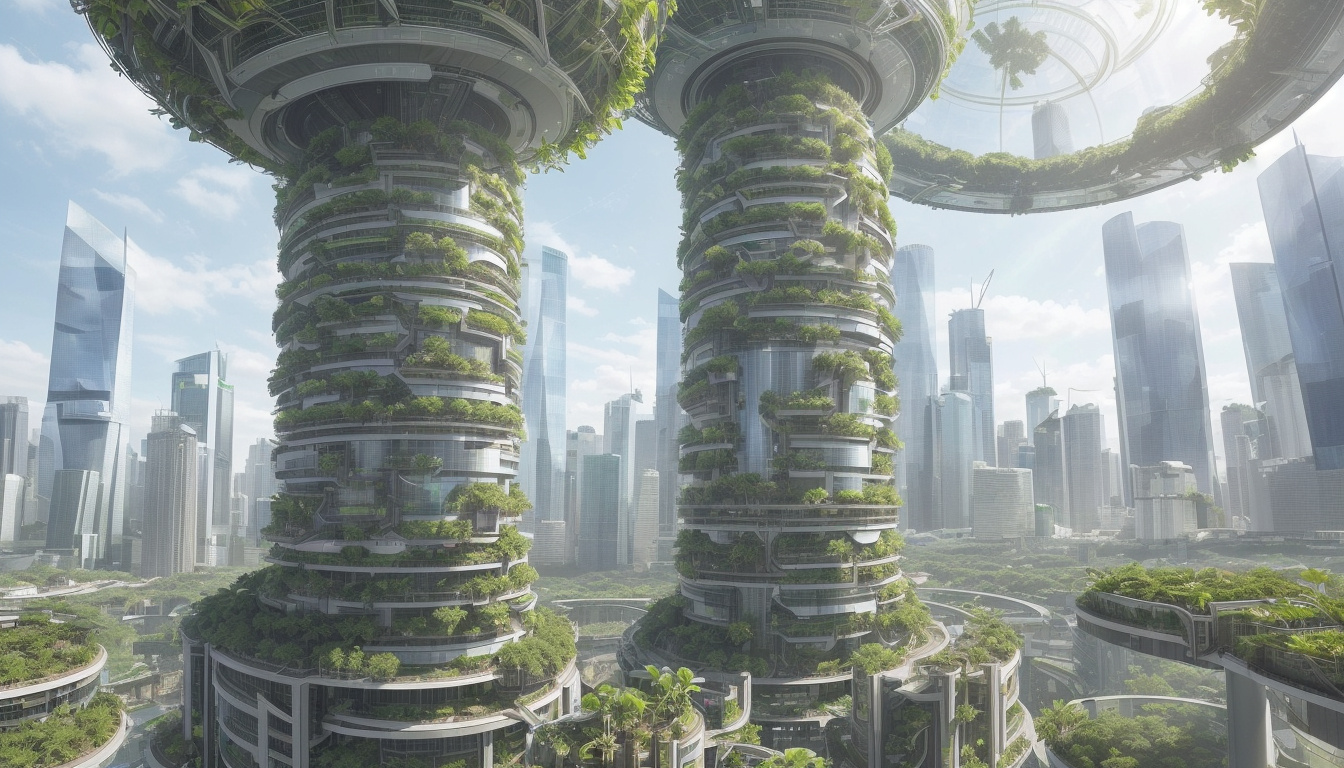Unlocking the Future of Food: How Vertical Farming is Revolutionizing Agriculture

Imagine walking into a farm that doesn’t stretch for miles but rather rises vertically, with rows of greens and vegetables growing upwards rather than outwards. Welcome to the fascinating world of vertical farming! This innovative approach to agriculture is revolutionizing the way we grow food, making it more sustainable, efficient, and accessible.
In this article, we'll explore what vertical farming is, its numerous benefits, the technological advancements propelling it forward, the positive impact on our environment, the challenges the industry faces, and what the future holds for this game-changing method of farming. Whether you're a consumer curious about your food sources, a health enthusiast seeking fresh produce, or a farmer looking for the next big thing in agriculture, vertical farming has something to offer you.
Interested in our Digital Magazine APP?

Here's a thought
- Vertical farming utilizes limited space to grow crops vertically, maximizing land use.
- It offers numerous benefits such as reduced water consumption and increased crop yield.
- Technological innovations, including LED lighting and automation, are enhancing vertical farming efficiency.
- Vertical farming has a positive environmental impact by reducing carbon footprints and pesticide use.
- Despite its promise, the vertical farming industry faces challenges like high startup costs and energy demands.
Introduction to Vertical Farming
Welcome to the world of vertical farming! If you’re a health enthusiast, a farmer looking to innovate, or simply someone interested in sustainable agriculture, you’re in the right place.
Vertical farming is an innovative agricultural practice where crops are grown in vertically stacked layers or structures, often utilizing controlled-environment agriculture (CEA) technology. Picture this: instead of sprawling fields, imagine multi-tiered farms that can fit in urban settings, producing fresh produce right where it's needed most.
Not only does vertical farming save space and water, but it also minimizes the reliance on pesticides and fertilizers, making it a key player in creating a more sustainable food system for our growing population. Whether you’re curious about the benefits for home gardening or the potential for commercial agriculture, understanding vertical farming can open up a world of healthy possibilities!
The Benefits of Vertical Farming
When it comes to sustainable agriculture, vertical farming is taking the spotlight, reshaping how we think about food production. Imagine being able to grow fresh, nutritious vegetables right in your city—reducing the need for long-distance transportation and cutting back on carbon emissions.
This innovative approach to farming utilizes stacked layers of crops, often in controlled indoor environments, which means you can grow food year-round, regardless of the weather outside. For health enthusiasts, this translates to access to fresher produce, free from harmful pesticides and preservatives.
For farmers, vertical farming presents an opportunity to maximize yield on smaller footprints, drastically increasing efficiency. And it’s not just about the food; by using less water and land, vertical farms contribute to a more sustainable planet.
Whether you're a consumer looking for fresher options, a health enthusiast wanting to eat clean, or a farmer eager to embrace new technology, vertical farming is opening up exciting possibilities.
'The future of food is not only about what we grow, but how we grow it. Vertical farming is not just a technique; it’s a revolution that can nourish our planet sustainably.' - Unknown
We publish a quarterly magazine available in IOS, Android and Web reader. Stories and articles curated from amazing people all around the world.
Technological Innovations Driving Vertical Farming
When we talk about vertical farming, we’re diving into a fascinating world where technology meets agriculture in the most innovative ways. Imagine growing fresh vegetables and herbs in multi-layered systems, often inside urban buildings or warehouses, using minimal space and resources.
The heart of this revolution is driven by advancements in LED lighting, hydroponics, and automated systems. LED lights mimic natural sunlight, allowing us to grow plants indoors year-round, significantly increasing yield and reducing the carbon footprint associated with traditional farming.
Hydroponics, on the other hand, enables plants to thrive without soil, using nutrient-rich water instead, which leads to faster growth cycles and healthier crops.
Additionally, automation technology, including sensors and AI-driven analytics, helps farmers monitor plant health and environmental conditions in real-time, ultimately boosting efficiency and productivity.
For health enthusiasts, this means fresher, chemical-free produce at their fingertips, while farmers can maximize their yield in smaller spaces, making vertical farming a sustainable choice for the future.
Interested in our Digital Magazine APP?

Environmental Impact of Vertical Farming
When we talk about sustainability and the future of agriculture, one term keeps coming up: vertical farming. This innovative approach not only maximizes space but significantly reduces the environmental impact associated with traditional farming practices.
Imagine growing fresh produce in vertically stacked layers, often incorporating hydroponics or aeroponics systems, which drastically cut down the need for land and water compared to conventional agriculture.
Vertical farming minimizes carbon emissions by sourcing food closer to urban markets, thereby reducing transportation footprints. Additionally, it eliminates the use of harmful pesticides and fertilizers, creating a cleaner, more sustainable environment.
Whether you're a consumer looking for healthier food options, a health enthusiast seeking nutrient-dense produce, or a farmer exploring sustainable methods, understanding the environmental impact of vertical farming is essential.
By embracing this revolutionary farming method, we can collectively work towards a greener planet, ensuring fresh food is available without depleting our precious natural resources.
Challenges Facing the Vertical Farming Industry
Vertical farming has emerged as an innovative solution to some of the pressing challenges faced by traditional agriculture, yet it is not without its hurdles. One of the most significant challenges facing the vertical farming industry is the high initial investment required to set up such operations. The costs associated with advanced technology, such as LED lighting and climate control systems, can be daunting for new entrepreneurs and farmers considering the shift to vertical farming.
Furthermore, there is the challenge of achieving operational efficiency; maintaining optimal growing conditions for various crops while minimizing energy consumption requires a delicate balance. Additionally, as the industry is still relatively young, there is a lack of established guidelines and best practices, leading to difficulties in scaling operations effectively.
This uncertainty can deter investment and slow down the growth of vertical farming as a sustainable alternative to conventional agriculture. Despite these challenges, the potential benefits—such as reduced land use and year-round crop production—keep the conversation going about the bright future of vertical farming.
Here's something people ask about
What is vertical farming?
Vertical farming is an innovative agricultural practice that involves growing crops in stacked layers, often utilizing controlled-environment agriculture (CEA) technology to optimize plant growth. This method can be used in various environments, such as urban settings, where space is limited.
What are the main benefits of vertical farming?
Vertical farming offers several benefits including increased crop yields, reduced land usage, minimized water consumption, shorter supply chains, and the ability to grow food year-round, regardless of outdoor climate conditions.
How does technology play a role in vertical farming?
Technological innovations such as hydroponics, aeroponics, LED lighting, and automated systems are crucial in vertical farming. They help optimize growth conditions, increase efficiency, and manage resources effectively, making farming more sustainable.
What environmental impacts does vertical farming have?
Vertical farming can significantly reduce the environmental impact of agriculture by using less land and water, minimizing pesticide use, and decreasing CO2 emissions associated with transporting food from rural farms to urban areas.
What challenges does the vertical farming industry face?
Despite its advantages, vertical farming faces challenges such as high initial capital costs, energy demands for lighting and climate control, and the need for advanced technology and skilled labor to manage operations efficiently.
We're striving to bring a range of different topics that relate to the Farming Food & Health sector. If you've got a question, please feel free to contact us.



